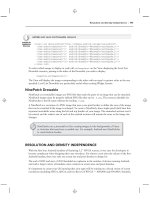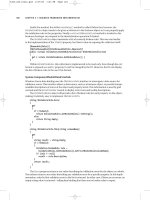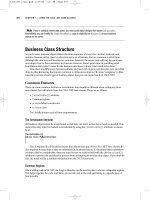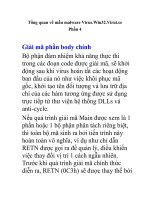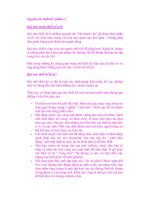C# Bible 2002 phần 4 ppsx
Bạn đang xem bản rút gọn của tài liệu. Xem và tải ngay bản đầy đủ của tài liệu tại đây (358.14 KB, 50 trang )
• Unary minus
• Logical negation
• Bitwise complement operator
• Prefix increment
• Prefix decrement
• The true keyword
• The false keyword
Overloading unary plus
If you need to overload the unary plus, unary minus, negation, or bitwise complement
operators in your class or structure, define a method with the following characteristics:
• A return type of your choice
• The keyword operator
• The operator being overloaded
• A parameter list specifying a single parameter of the type of class or structure
containing the overloaded operator method
As an example, revisit the Point class from Chapter 9. Suppose that you want to add a unary
plus operator to the class that, when used, ensures that the coordinates of the point are both
positive. This is implemented in Listing 10-1.
Listing 10-1: Overloading the Unary Plus Operator
class Point
{
public int X;
public int Y;
public static Point operator + (Point RValue)
{
Point NewPoint = new Point();
if(RValue.X < 0)
NewPoint.X = -(RValue.X);
else
NewPoint.X = RValue.X;
if(RValue.Y < 0)
NewPoint.Y = -(RValue.Y);
else
NewPoint.Y = RValue.Y;
return NewPoint;
}
public static void Main()
{
Point MyPoint = new Point();
MyPoint.X = -100;
MyPoint.Y = 200;
System.Console.WriteLine(MyPoint.X);
System.Console.WriteLine(MyPoint.Y);
MyPoint = +MyPoint;
System.Console.WriteLine(MyPoint.X);
System.Console.WriteLine(MyPoint.Y);
}
}
The Main() method creates an object of type Point and sets its initial coordinates to (100,
200). It then applies the unary plus operator to the object and reassigns the result to the same
point. It prints out the x and y coordinates to the console.
The output of Listing 10-1 is shown in Figure 10-1.
Figure 10-1: Overloading the unary operator
The coordinates of the point have changed from (-100, 200) to (100, 200). The overloaded
operator code is executed when the following statement is reached:
MyPoint = +MyPoint;
When this statement is reached, the unary plus operator overload for the Point class is
executed. The expression on the right side of the equal sign is supplied as the parameter to the
method.
N
ote The expression on the right-hand side of an assignment operator is often referred to as
an rvalue, which is short for "right value." The expression on the left-hand side of an
assignment operator is often referred to an lvalue, which is short for "left value."
N
aming the parameter in the operator overload method RValue makes it clear that the
rvalue of the assignment is being passed in. This is just a naming convention and not a
requirement. You are free to name your parameters using any legal identifier allowed by
C#.
This method creates a new Point object and then examines the coordinates of the supplied
rvalue. If either of the parameters is negative, their values are negated, thereby turning them
to positive values; and the now-positive values are assigned to the new point. Values that are
not negative are assigned to the new point without any conversion. The new point is then
returned from the method. The return value from the operator is used as the lvalue for the
original statement.
The return type of operator overloads for the unary plus, unary minus, negation, or bitwise
complement operators does not have to be the same type as the rvalue. It can be any C# type
that makes the most sense for the operator.
Overloading unary minus
Much like the unary plus, you can perform the unary minus override in the very same fashion.
Listing 10-2 overrides the minus operator to handle the Point class.
Listing 10-2: Overloading Unary Minus
class Point
{
public int X;
public int Y;
public static Point operator - (Point RValue)
{
Point NewPoint = new Point();
if (RValue.X > 0)
NewPoint.X = -(RValue.X);
else
NewPoint.X = RValue.X;
if (RValue.Y > 0)
NewPoint.Y = -(RValue.Y);
else
NewPoint.Y = RValue.Y;
return NewPoint;
}
public static void Main()
{
Point MyPoint = new Point();
MyPoint.X = -100;
MyPoint.Y = 200;
System.Console.WriteLine(MyPoint.X);
System.Console.WriteLine(MyPoint.Y);
MyPoint = -MyPoint;
System.Console.WriteLine(MyPoint.X);
System.Console.WriteLine(MyPoint.Y);
}
}
After you define your new Point operator, you simply define the action it should take when
presented with a variable of type Point. Listing 10-2 declares the x coordinate as -100 and the
y coordinate as 200. You print these values out to the console for visual verification and then
use your overloaded operator.
After your sample application has subtracted from the Point class, the resulting values are
printed to the console window to indicate that it behaved as expected. Figure 10-2 is the
output from Listing 10-2.
Figure 10-2: Overloading unary minus
So far, this chapter has covered unary minus and unary plus. These operators perform
operations given one value — hence, the "unary." Other basic mathematical operators that can
be used on one value are overloaded in the same fashion.
The next section
describes an operator of a different kind — the bitwise complement operator.
Overloading bitwise complement
The bitwise complement operator only has definitions for int, uint, long, and ulong. Listing
10-3 overloads it to work with the point class.
Listing 10-3: Overloading the Bitwise Complement Operator
class Point
{
public int X;
public int Y;
public static Point operator ~ (Point RValue)
{
Point NewPoint = new Point();
NewPoint.X = ~RValue.X;
NewPoint.Y = ~RValue.Y;
return NewPoint;
}
public static void Main()
{
Point MyPoint = new Point();
MyPoint.X = 5;
MyPoint.Y = 6;
System.Console.WriteLine(MyPoint.X);
System.Console.WriteLine(MyPoint.Y);
MyPoint = ~MyPoint;
System.Console.WriteLine(MyPoint.X);
System.Console.WriteLine(MyPoint.Y);
}
}
The output of a bitwise complement operation doesn't become apparent until you view the hex
results of the operation. Listing 10-3 generates the complement of the integer values 5 and 6.
The output of this operation (shown in Figure 10-3) is -6 and -7, respectively. When you view
the hex values of the input and output values, you soon realize what is actually happening.
Figure 10-3: Overloading the bitwise complement
Table 10-1: Input and Output Values for a Bitwise Complement Operation
Input Output
0x0000000000000005 0xfffffffffffffffA
0x0000000000000006 0xfffffffffffffff9
Before you overload an operator, it is imperative that you fully understand how it works.
Otherwise, you may end up with some unexpected results.
Overloading the prefix increment
If you need to overload the prefix increment or prefix decrement operators in your class or
structure, define a method with the following characteristics:
• A return type specifying the type of class or structure containing the overloaded
operator method
• The keyword operator
• The operator being overloaded
• A parameter list specifying a single parameter of the type of class or structure
containing the overloaded operator method
For an example, look at Listing 10-4. This class modifies the Point class to overload the prefix
increment operator. The operator is overloaded to increment the x and y coordinates by one
unit.
Listing 10-4: Overloading the Prefix Increment
class Point
{
public int X;
public int Y;
public static Point operator ++ (Point RValue)
{
Point NewPoint = new Point();
NewPoint.X = RValue.X + 1;
NewPoint.Y = RValue.Y + 1;
return NewPoint;
}
public static void Main()
{
Point MyPoint = new Point();
MyPoint.X = 100;
MyPoint.Y = 200;
System.Console.WriteLine(MyPoint.X);
System.Console.WriteLine(MyPoint.Y);
MyPoint = ++MyPoint;
System.Console.WriteLine(MyPoint.X);
System.Console.WriteLine(MyPoint.Y);
}
}
Compiling and running the code in Listing 10-4 writes the following to the console:
100
200
101
201
Overloading the prefix decrement
Now you'll examine how to overload the decrement operator to handle the Point class. Listing
10-5 contains the complete code listing to overload the operator much like that of the prefix
increment operator just covered.
Listing 10-5: Overloading the Prefix Decrement Operator
class Point
{
public int X;
public int Y;
public static Point operator (Point RValue)
{
Point NewPoint = new Point();
NewPoint.X = RValue.X - 1;
NewPoint.Y = RValue.Y - 1;
return NewPoint;
}
public static void Main()
{
Point MyPoint = new Point();
MyPoint.X = 100;
MyPoint.Y = 200;
System.Console.WriteLine(MyPoint.X);
System.Console.WriteLine(MyPoint.Y);
MyPoint = MyPoint;
System.Console.WriteLine(MyPoint.X);
System.Console.WriteLine(MyPoint.Y);
}
}
Figure 10-4: Output from compiling and running the code in Listing 10-4
Again, you pass in an x coordinate of 100 and a y coordinate of 200. Figure 10-5 contains the
output of this program after your overload decrement operator has subtracted from both x and
y.
Figure 10-5: Overloading the prefix decrement operator
Always assume the worst when overloading operators. It is always possible that the data being
passed in may be bad, and you'll find that your overloaded function isn't equipped to handle
the data. The previous examples don't bother to catch exceptions that may be thrown when
bad or unexpected values are passed in. It's a good idea to play around with the functions and
attempt to beef up the error trapping a bit.
Overloading the true and false operators
If you need to overload the true or false operators in your class or structure, define a method
with the following characteristics:
• A return type of bool
• The keyword operator
• The operator being overloaded
• A parameter list specifying a single parameter of the type of class or structure
containing the overloaded operator method
For an example, look at Listing 10-6. It modifies the point class to evaluate to true whether
the point is on the origin and to evaluate to false otherwise.
Listing 10-6: Overloading the True and False Operators
class Point
{
public int X;
public int Y;
public static bool operator true (Point RValue)
{
if((RValue.X == 0) && (RValue.Y == 0))
return true;
return false;
}
public static bool operator false (Point RValue)
{
if((RValue.X == 0) && (RValue.Y == 0))
return false;
return true;
}
public static void Main()
{
Point MyPoint = new Point();
MyPoint.X = 100;
MyPoint.Y = 200;
if(MyPoint)
System.Console.WriteLine("The point is at the origin.");
else
System.Console.WriteLine("The point is not at the origin.");
}
}
Overloading the true and false operators allows objects of the Point class to be used as
Boolean expressions, as in the if statement. Because the MyPoint object is not at the origin,
the object evaluates to false, as shown in Figure 10-6
.
Figure 10-6: Overloading the true and false operators
If either the true or false operators are overloaded for a class or structure, they both must be
overloaded. If you overload one but not the other, the C# compiler issues an error message
like the following:
error CS0216: The operator 'Point.operator true(Point)'
requires a matching operator 'false' to also be defined
Overloadable Binary Operators
Following is a list of the binary operators that can be overloaded:
• Addition
• Subtraction
• Multiplication
• Division
• Remainder
• AND
• OR
• Exclusive OR
• Shift left
• Shift right
• Equality
• Inequality
• Greater than
• Less than
• Greater than or equal to
• Less than or equal to
If you need to overload any of the binary operators in your class or structure, define a method
with the following characteristics:
• A return type of your choice
• The keyword operator
• The operator being overloaded
• A parameter list specifying two parameters, at least one of which must be of the type
of class or structure containing the overloaded operator method
Overloading binary operators enables you to be very flexible. You can use different
parameters for the two parameters in the parameter list, which means that you can apply the
operator to two values of different types if you wish. You can also use any available type as
the return value from the overloaded operator. If you need to add together an object and a
floating-point value and get a Boolean result, you can write an overloaded method as follows:
static public bool operator + (Point MyPoint, float FloatValue)
You can define multiple overloads of the same operator if you want, but only if the parameter
lists use different types:
static public bool operator + (Point MyPoint, float FloatValue)
static public bool operator + (Point MyPoint, int IntValue)
static public bool operator + (Point MyPoint, uint UIntValue)
Listing 10-7 provides an example. It adds overloaded equality and inequality operators to the
Point class. The operators return Boolean results that evaluate to true if two Point objects have
the same coordinates; otherwise, the results evaluate to false.
Listing 10-7: Overloading the Equality and Inequality Operators
class Point
{
public int X;
public int Y;
public static bool operator == (Point Point1, Point Point2)
{
if(Point1.X != Point2.X)
return false;
if(Point1.Y != Point2.Y)
return false;
return true;
}
public override bool Equals(object o)
{
return true;
}
public override int GetHashCode()
{
return 0;
}
public static bool operator != (Point Point1, Point Point2)
{
if(Point1.X != Point2.X)
return true;
if(Point2.Y != Point2.Y)
return true;
return false;
}
public static void Main()
{
Point MyFirstPoint = new Point();
Point MySecondPoint = new Point();
Point MyThirdPoint = new Point();
MyFirstPoint.X = 100;
MyFirstPoint.Y = 200;
MySecondPoint.X = 500;
MySecondPoint.Y = 750;
MyThirdPoint.X = 100;
MyThirdPoint.Y = 200;
if(MyFirstPoint == MySecondPoint)
System.Console.WriteLine("MyFirstPoint and MySecondPoint are at
the
same coordinates.");
else
System.Console.WriteLine("MyFirstPoint and MySecondPoint are
not at
the same coordinates.");
if(MyFirstPoint == MyThirdPoint)
System.Console.WriteLine("MyFirstPoint and MyThirdPoint are at
the
same coordinates.");
else
System.Console.WriteLine("MyFirstPoint and MyThirdPoint are not
at
the same coordinates.");
}
}
The Main() method defines three points:
• MyFirstPoint, with coordinates of (100, 200)
• MySecondPoint, with coordinates of (500, 750)
• MyThirdPoint, with coordinates of (100, 200)
The method then uses the equality operator to determine whether the MyFirstPoint point and
the MySecondPoint refer to the same coordinates. It then uses the equality operator to
determine whether the MyFirstPoint point and the MyThirdPoint refer to the same
coordinates.
Compiling and executing the code in Listing 10-7
results in the output shown in Figure 10-7.
Figure 10-7: Overloading the equality and inequality operators
The following pairs of operators must be overloaded together:
• Equality and inequality
• Less than and greater than
• Less than or equal to and greater than or equal to
If you overload one of these pairs but not the other, the C# compiler issues an error message
like the following:
error CS0216: The operator 'Point.operator ==(Point, Point)'
requires a matching operator '!=' to also be defined
Overloadable Conversion Operators
You can also write operator overload methods that convert one type into another type. Your
overload method can also define whether the C# compiler should treat the conversion as an
implicit or explicit conversion.
If you need to define a new conversion operator in your class or structure, define a method
with the following characteristics:
• The keyword implicit if the conversion is to be treated as an implicit conversion, or
the keyword explicit if the conversion is to be treated as an explicit conversion
• The keyword operator
• A type specifying the target type of the conversion
• A parameter list specifying the source type of the conversion
Listing 10-8 defines an implicit conversion from a Point class object to a double. The double
specifies the distance from the origin to the point, using the Pythagorean theorem.
Listing 10-8: Defining an Implicit Conversion
class Point
{
public int X;
public int Y;
public static implicit operator double(Point RValue)
{
double Distance;
double Sum;
Sum = (RValue.X * RValue.X) + (RValue.Y * RValue.Y);
Distance = System.Math.Sqrt(Sum);
return Distance;
}
public static void Main()
{
double Distance;
Point MyPoint = new Point();
MyPoint.X = 100;
MyPoint.Y = 200;
Distance = MyPoint;
System.Console.WriteLine(Distance);
}
}
N
ote The System.Math.Sqrt() method is defined by the .NET Framework and calculates the
square root of the supplied parameter. The method is static, so you can call it without
having an object of the System.Math type to call it on.
The Main() method declares an object of type Point and sets its coordinates to (100, 200). It
then assigns the object to a variable of type double, which is legal because the Point class
defines a conversion operator that converts a Point object to a double. Because the conversion
operator is defined as an implicit conversion, no casting is required. The Main() method then
prints the value of the converted double to the console.
Figure 10-8 shows the output of Listing 10-8.
Figure 10-8: Defining an implicit conversion
Operators That Cannot Be Overloaded
C# does not enable you to redefine the behavior of the operators in the following list. This is
mainly for simplicity's sake. The designers of the C# language wanted these operators kept
simple, and to always perform their intended function; therefore, no overloading is allowed.
• Assignment
• Conditional AND
• Conditional OR
• Conditional
• The new, typeof, sizeof, and is keywords
Summary
C# enables you to tailor the behavior of several of the built-in operators to your own needs.
Classes and structures can include methods called operator overload methods that define the
behavior of an operator when it appears in an expression with your class or structure.
To overload the unary plus, unary minus, negation, or bitwise complement operators in your
class or structure, you define a method with a return type of your choice, the operator being
overloaded, and a single parameter of the type of class or structure containing the overloaded
operator method.
To overload the prefix increment or prefix decrement operators in your class or structure, you
define a method with a return type specifying the type of class or structure containing the
overloaded operator method. You also need to define the operator being overloaded and a
single parameter of the type of class or structure containing the overloaded operator method.
To overload the true or false operators in your class or structure, you define a method with a
Boolean return type, the operator being overloaded, and a single parameter of the type of class
or structure containing the overloaded operator method.
To overload any of the binary operators in your class or structure, you define a method with a
return type, the operator being overloaded, and two parameters. At least one of the two
parameters must be of the type of class or structure containing the overloaded operator
method.
You can also define new conversions for your classes or structures. You specify whether the
conversion is to be treated as an implicit operator or an explicit operator. The conversion
operator method specifies both the type of the variable being converted as well as the type to
which the variable should be converted.
Chapter 11: Class Inheritance
In This Chapter
Simple C# projects may use one or two classes. However, you will most likely write many
classes in your larger C# projects. Many of these classes may have similar fields or methods,
and it may make sense to share common code among a set of classes.
C# embraces the object-oriented concept of inheritance, which allows one class to inherit
code from another class. C# classes can inherit code from parent classes, and the inherited
constructs can be used in your own classes.
Inheritance is used in object-oriented software development to re-use common code. Take, for
example, the single-selection and multiple-selection list boxes found in Windows. The two
list boxes have different functionality - one allows multiple items to be selected and the other
doesn't - but they also have many similarities. They both look the same, they both behave the
same when the user scrolls through the list, and the color used for a selected item is the same.
If you were to write these two list boxes as C# classes, you could write them separately, with
each one having no knowledge of the other. However, that would be a waste. Much of the
code would be identical. It would make more sense to write a class to contain the common
code and have classes that derive from the common code class that implement the different
functionality. You can write a C# class called ListBox to hold the common code, for example,
and you can then write a C# class called SingleSelectionListBox that inherits from ListBox
and supplies the code unique to the single-selection list box. You may also write a C# class
called MultipleSelectionListBox that also inherits from ListBox but supplies the code unique
to the multiple-selection list box.
Another advantage in this scenario relates to maintaining your code. If you find a bug in your
list box, you can trace it back to a bug in the common code. If you can fix the bug in the
common code, recompiling your project will fix the bug in both the single-selection and
multiple-selection list box classes. One bug fix fixes the problem in two classes.
In object-oriented terminology, inheritance is discussed in terms of a base class and a derived
class. The class being inherited from is called the base class, and the class inheriting from the
base class is called the derived class. In the list box scenario, the ListBox class is the base
class and the SingleSelectionListBox and the MultipleSelectionListBox classes are the
derived classes.
Compiling with Multiple Classes
Working with inheritance in C# means that you'll be working with more than one C# class.
C# is not picky about how those classes are arranged relative to your source files. You can put
all of your classes in a single source file, or you can put each class in a separate source file.
Obviously, in all but the smallest of projects, implementing all the classes in a single file is a
poor way of organizing your code. One reason this is a poor idea is that all classes are
recompiled every time you make a change anywhere in the program. To compile a project
using separate source files from the command line, you simply list each file after the compiler
name as follows:
csc file1.cs file2.cs file3.cs
The C# compiler names the output executable after the first source filename by default. The
previous compiler command line produces an executable called file1.exe. If you don't like this
default, you can use the /out argument to change the output file's name:
csc /out:myapp.exe file1.cs file2.cs file3.cs
This compiler command line produces an executable called myapp.exe.
N
ote Remember that one, and only one, of your classes must specify a static Main() method.
Specifying a Base Class in C#
Let's return to our Point class example for a look at how inheritance works in C#. Suppose
you've designed a class called Point2D, which describes a point in 2D space with X and Y
coordinates:
class Point2D
{
public int X;
public int Y;
// more code
}
Now suppose that you'd like to add support for points in 3D space while still keeping the
Point2D class. Inheritance enables you to design a new class that keeps all of the code written
for the Point2D class and adds a Z coordinate.
Naming the base class in C# is done by following your derived class name with a colon and
the name of the base class. Deriving the Point3D class from the Point2D class looks like the
following:
class Point3D : Point2D
{
public int Z;
// code for Point3D class
}
Depending on the base class's scoping rules, which are covered in the "Scope" section of this
chapter, all the fields and properties in the base class (Point2D) are available for use in the
derived class (Point3D). For example, when a class is derived from a base class, the code in
the derived class has access to the fields and properties in the base class, depending on the
scope.
You can list only a single base class when inheriting one class from another. Some object-
oriented languages, such as C++, allow you to specify more than one base class for a derived
class. This concept is called multiple inheritance. C# supports single inheritance but not
multiple inheritance. In the section discussing containment. you see a technique to simulate
multiple inheritance in C#.
Listing 11-1 shows how the Point3D class and the Point2D class can be used together.
Listing 11-1: Deriving Point3D from Point2D
class Point2D
{
public int X;
public int Y;
}
class Point3D : Point2D
{
public int Z;
}
class MyMainClass
{
public static void Main()
{
Point2D My2DPoint = new Point2D();
Point3D My3DPoint = new Point3D();
My2DPoint.X = 100;
My2DPoint.Y = 200;
My3DPoint.X = 150;
My3DPoint.Y = 250;
My3DPoint.Z = 350;
}
}
Note that the Main() method creates a Point2D object and a Point3D object. The Point3D
object has fields for X, Y, and Z coordinates, although the declaration of Point3D only
declares a field called Z. The X and Y fields are inherited from the Point2D base class and can
be used just as if they were declared directly in the Point3D class.
Scope
When you design your class inheritance architecture, you may decide that members in your
base class should not be visible to derived classes or to the outside world. For example, you
may write a method in a base class that helps calculate a value. If that calculation is not useful
in a derived class, you may want to prevent the derived class from even calling the method.
In programming terminology, the visibility of a variable or method is referred to as its scope.
Some variables or methods may be publicly scoped, others may be privately scoped, and still
others may be somewhere in between.
C# defines five keywords that enable you to define the scope of any member (either variable
or method) in a class. A member's scope affects its visibility to derived classes and code that
creates instances of the class. These keywords, outlined in the following list, are placed before
any other keywords in a member declaration.
• Members marked public are visible to derived a class and to code that creates objects
of the class. We've been using public up to this point.
• Members marked private are visible only to the class in which they are defined.
Private members are not accessible from derived classes, nor are they accessible from
code that creates objects of the class.
• Members marked protected are visible only to the class in which they are defined or
from classes derived from the class. Protected members are not accessible from code
that creates objects of the class.
• Members marked internal are visible to any code in the same binary file, but are not
visible to any code in other binary files. Remember that the .NET Framework
embraces the concept of assemblies, which are libraries of precompiled code that can
be used by external applications. If you write a class in C# and compile the class into
an assembly, internal class members can be accessed by any piece of code in the
assembly. However, if another piece of code uses your assembly, it has no access to
the member, even if it derives a class from your assembly class.
• Members marked protected internal are visible to any code in the same binary file and
to external classes that derive from the class. If you write a class in C# and compile
the class into an assembly, internal class members can be accessed by any piece of
code in the assembly. If another piece of external code uses your assembly, and
derives a class from the class in the assembly, the protected internal member is
accessible to the derived class. The member is not, however, accessible to code that
works with objects of the base class.
C# enables you to specify a class member without specifying any scope keywords. If you
declare a class member without specifying any scope keywords, the member is given private
accessibility by default. Members declared without any scope keywords can be used in other
parts of the class, but cannot be used by derived classes or by code that uses objects of the
class.
Re-using Member Identifiers in Derived Classes
C# enables you to re-use base class identifiers in derived classes, but the C# compiler issues a
warning when this is detected. Consider the code shown in Listing 11-2.
Listing 11-2: Re-using Base Class Identifiers
class Point2D
{
public int X;
public int Y;
}
class Point3D : Point2D
{
public int X;
public int Y;
public int Z;
}
class MyMainClass
{
public static void Main()
{
Point2D My2DPoint = new Point2D();
Point3D My3DPoint = new Point3D();
My2DPoint.X = 100;
My2DPoint.Y = 200;
My3DPoint.X = 150;
My3DPoint.Y = 250;
My3DPoint.Z = 350;
}
}
The derived Point3D class defines X and Y fields that clash with the identifiers used in the
Point2D base class. The C# compiler issues warnings when this code is compiled:
warning CS0108: The keyword new is required on 'Point3D.X'
because it hides inherited member 'Point2D.X'
warning CS0108: The keyword new is required on 'Point3D.Y'
because it hides inherited member 'Point2D.Y'
The C# compiler issues the warnings because the identifiers in the derived class hide the
definitions using the same identifier in the base class. If you want to re-use the names and
want to instruct the C# compiler not to issue the warnings, use the new operator when re-
using the identifiers in the derived class. The code shown in Listing 11-3 compiles with no
warnings.
Listing 11-3: Using new to Re-use Base Class Identifiers
class Point2D
{
public int X;
public int Y;
}
class Point3D : Point2D
{
new public int X;
new public int Y;
public int Z;
}
class MyMainClass
{
public static void Main()
{
Point2D My2DPoint = new Point2D();
Point3D My3DPoint = new Point3D();
My2DPoint.X = 100;
My2DPoint.Y = 200;
My3DPoint.X = 150;
My3DPoint.Y = 250;
My3DPoint.Z = 350;
}
}
Working with Inherited Methods
C# enables methods in base and derived classes to interact in a variety of ways. The language
allows for the following method constructs:
• Virtual and override methods
• Abstract methods
Virtual and override methods
You may want a derived class to change the implementation of a method in a base class while
keeping the method name the same. Suppose, for example, that our Point2D class implements
a method called PrintToConsole(), which prints the point's X and Y coordinates out to the
console. You may also want the derived Point3D class to provide its own implementation of
PrintToConsole(). It cannot use the PrintToConsole() method provided in the Point2D class,
however, because that implementation only works with X and Y coordinates, and the Point3D
class has a Z coordinate as well. The Point3D class must provide its own implementation of
the same PrintToConsole() method.
Method names can be re-used in derived classes if the base class method allows the method to
be re-implemented. Re-implementing a base class method in a derived class is called
overriding the base class method. You need to be aware of two requirements when overriding
a base class method in C#:
• The base class method must be declared with the keyword virtual.
• The derived class method must be declared with the keyword override.
Base class methods using the virtual keyword are called virtual methods, and derived class
methods using the override keyword are called override methods.
Listing 11-4 shows how the PrintToConsole() method can be implemented for both the
Point2D and the Point3D classes.
Listing 11-4: Overriding Virtual Methods
class Point2D
{
public int X;
public int Y;
public virtual void PrintToConsole()
{
System.Console.WriteLine("({0}, {1})", X, Y);
}
}
class Point3D : Point2D
{
public int Z;
public override void PrintToConsole()
{
System.Console.WriteLine("({0}, {1}, {2})", X, Y, Z);
}
}
class MyMainClass
{
public static void Main()
{
Point2D My2DPoint = new Point2D();
Point3D My3DPoint = new Point3D();
My2DPoint.X = 100;
My2DPoint.Y = 200;
My3DPoint.X = 150;
My3DPoint.Y = 250;
My3DPoint.Z = 350;
My2DPoint.PrintToConsole();
My3DPoint.PrintToConsole();
}
}
N
ote The syntax of the WriteLine() calls made in Listing 11-4 is different than the syntax
used previously in this book. The numbers in curly brackets in the string are
p
laceholders. The values of the other parameters are written to the console instead of the
p
laceholder. The {0} placeholder is replaced with the value of the first parameter after
the string parameter, the {1} placeholder is replaced with the value of the second
p
arameter after the string parameter, and so on.
Listing 11-4 prints the following to the console:
(100, 200)
(150, 250, 350)
You cannot override a base class method unless the base class method uses the virtual
keyword. If you try to do this, the C# compiler issues an error:
error CS0506: 'Point3D.PrintToConsole()' : cannot override
inherited member 'Point2D.PrintToConsole()' because it is not
marked virtual, abstract, or override
You can, however, override an override method. If, for some odd reason, you decide to
implement a Point4D class and derive it from Point3D, you can override the Point3D's
PrintToConsole() method.
Polymorphism
The concept of overriding methods leads to the concept of polymorphism. When you override
a method, you want the correct method called from any methods that call this overridden
method.
Listing 11-5 shows this concept in action. You have added a UsePrintToConsole() method to
Point2D that calls the virtual method PrintToConsole(). Point3D inherits this method from
Point2D. When PrintToConsole() is called in this function, you want to call the version that
belongs to the appropriate class. In other words, in the UsePrintToConsole() method that
belongs to the Point2D class, you want to call the PrintToConsole() method that belongs to
the Point2D class. In the UsePrintToConsole() method that belongs to the Point3D class, you
want to call the overridden PrintToConsole() method that belongs to the Point3D class.
Because the PrintToConsole() method was declared as a virtual method, this detecting of
which version to run happens automatically.
This is exactly what happens, as Listing 11-5
prints the following to the console:
(100, 200)
(150, 250, 350)
Listing 11-5: Polymorphism
class Point2D
{
public int X;
public int Y;
public virtual void PrintToConsole()
{
System.Console.WriteLine("({0}, {1})", X, Y);
}
public void UsePrintToConsole()
{
PrintToConsole();
}
}
class Point3D : Point2D
{
public int Z;
public override void PrintToConsole()
{
System.Console.WriteLine("({0}, {1}, {2})", X, Y, Z);
}
}
class MyMainClass
{
public static void Main()
{
Point2D My2DPoint = new Point2D();
Point3D My3DPoint = new Point3D();
My2DPoint.X = 100;
My2DPoint.Y = 200;
My3DPoint.X = 150;
My3DPoint.Y = 250;
My3DPoint.Z = 350;
My2DPoint.UsePrintToConsole();
My3DPoint.UsePrintToConsole();
}
}
Abstract methods
Some base classes may not be able to provide an implementation of a method but you may
still want to require that derived classes provide an implementation. Suppose, for example,
that you're writing a geometry application in C# and write classes called Square and Circle.
You decide upon some common functionality that every shape will use in your application, so
you implement a base class called Shape and derive the Square and Circle classes from Shape:
Class Shape
{
}
class Circle : Shape
{
}
class Square : Shape
{
}
Now suppose that you decide that all shapes should be able to calculate their area, so you
write a method called GetArea(). The problem with writing that code in the Shape base class
is that the base class does not have enough information to calculate an area. Each shape
calculates its area using a different formula.
What you can do is define an abstract method in the Shape base class. Abstract methods do
not provide an implementation of their own, but provide a method signature that derived
classes must implement. Abstract methods say, "I don't know how to implement this method,
but my derived classes will, so make sure that they implement it with the parameters and the
return code that I specify." The following snippet shows how you can declare an abstract
method in the Shape class.
abstract class Shape
{
public abstract double GetArea();
}
N
ote Abstract classes use the abstract keyword. They do not have a method body; a
semicolon follows the parameter list instead.
Abstract classes are also, by definition, virtual methods, and must be overridden by derived
classes using the override keyword:
class Square : Shape
{
public override double GetArea()
{
// implement area calculation
}
}
Classes containing at least one abstract method are called abstract classes, and must include
the abstract keyword before the class keyword. If you forget the abstract keyword when
defining the class, you get an error from the C# compiler:
error CS0513: 'Shape.GetArea ()' is abstract but it is
contained in nonabstract class 'Shape'
The C# compiler doesn't allow you to create objects from abstract classes. If you try to create
an object from an abstract class, the C# compiler issues an error:
error CS0144: Cannot create an instance of the abstract class
or interface 'Shape'
Abstract classes are used most often to create a common base class to a set of classes. This
enables you to use polymorphism when storing derived classes in a collection of some sort.
You saw this in action in Chapter 8, " Writing Object-Oriented Code," with the Zoo example.
Base Classes: Working with Inherited Properties and
Indexers
With C#, you can mark properties and indexers in base and derived classes as virtual,
override, and abstract, just like methods.
N
ote Indexers are roughly equivalent to the overloaded [] operator and are declared using the
this[] syntax. You use them where you want to access a class property in an array-like
manner.
Virtual and override properties and indexers work just like virtual and override properties.
Properties and indexers may be marked as virtual in a base class and overridden in a derived
class.
Base classes may define abstract properties and indexers, which do not have an
implementation of their own. Base classes containing at least one abstract property or indexer
must be marked as an abstract class. Abstract properties and indexers must be overridden in a
base class.
Using the base keyword
The C# language provides the base keyword so that derived classes can access functionality in
their base class. You can use the keyword base to call a base class constructor when an object
of a derived class is created. To call a base class constructor, follow the derived class
constructor with a colon, the base keyword, and then the parameters to be passed to the base
class.
Listing 11-6 shows how this works. It adds constructors for the Point2D and Point3D classes,
and the Point3D constructor calls the constructor of its base class.
Listing 11-6: Calling Base Class Constructors
class Point2D
{
public int X;
public int Y;
public Point2D(int X, int Y)
{
this.X = X;
this.Y = Y;
}
public virtual void PrintToConsole()
{
System.Console.WriteLine("({0}, {1})", X, Y);
}
}
class Point3D : Point2D
{
public int Z;
public Point3D(int X, int Y, int Z) : base(X, Y)
{
this.Z = Z;
}
public override void PrintToConsole()
{
System.Console.WriteLine("({0}, {1}, {2})", X, Y, Z);
}
}
class MyMainClass
{
public static void Main()
{
Point2D My2DPoint = new Point2D(100, 200);
Point3D My3DPoint = new Point3D(150, 250, 350);
My2DPoint.PrintToConsole();
My3DPoint.PrintToConsole();
}
}
The constructor for the Point2D class sets the class's X and Y fields using the two integers
passed to the constructor. The constructor for the Point3D class accepts three parameters. The
first two parameters are passed to the base class's constructor using the base keyword, and the
third is used to set the derived class's Z field.
Accessing base class fields with the base keyword
You can also use the base keyword to access members in the base class. In your derived class,
you can work with a base class member by prefixing the member's name with the keyword
base and a period. You can access base class fields using the following syntax:
base.X = 100;
You can also invoke base class methods using this syntax:
base.PrintToConsole();
Sealed Classes
If you do not want code to derive from your class, you can mark your class with the sealed
keyword. You cannot derive a class from a sealed class.
You can specify a sealed class by placing the keyword sealed before the class keyword as
follows:
sealed class MySealedClass
If you try to derive a class from a sealed class, the C# compiler issues an error:
error CS0509: 'Point3D' : cannot inherit from sealed class
'Point2D'
Containment and Delegation
Whereas inheritance is an IS-A relationship, containment is a HAS-A relationship. A
Burmese IS A cat (so you might want to inherit your Burmese class from your generic Cat
class); whereas a Car HAS 4 tires (so your Car class may contain 4 Tire objects). The


